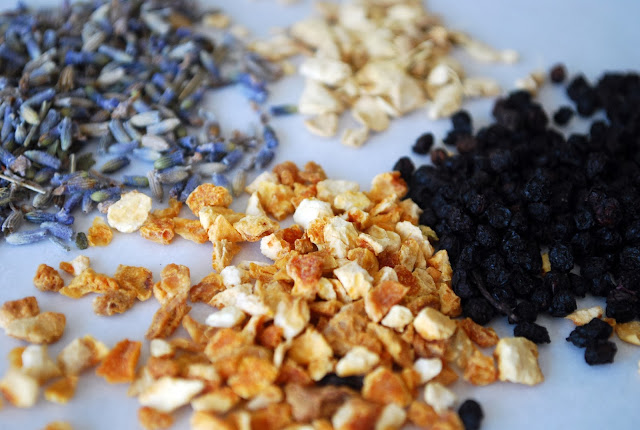I created this recipe a couple months ago as preparation for the months known for boasting illness - a foe I do everything possible to avoid. If anyone close to me catches a cold I immediately pop a bottle, sipping to freedom from phlegm and misery. Along with a few preventative measures, my body is able to put up a good fight and come away victorious.
 [WHAT'S SO GREAT ABOUT THIS COMBO?]
[WHAT'S SO GREAT ABOUT THIS COMBO?]Elderberries
Elderberries and elder flowers are pretty much considered the universal remedy. In most temperate regions its seems you can find these bushes everywhere. We have them lining the ditches along our roads, in the woods, throughout our gardens and farms, near ponds, you name it. They are easy to grow and really easy to dry and store. Elder's most touted properties are immune-enhancing, anti-viral, and sweat inducing [fever reducing]. They can also be used to treat upper respiratory infections, inflammation, skin problems [including boils, rashes, acne], or as a nutritive food [think vitamin A, vitamin C, bioflavonoids, flavonoids, phenolic compounds, beta-carotene, iron, potassium, and phytosterols].
*Note: it is important to use dried as raw berries can cause severe vomiting and diarrhea in some people.
Ginger
Okay I admit, I add ginger to everything. It is one of my favorite all-around herbs and also claimed to be a universal remedy. Not only an antiseptic [think food poisoning and gastrointestinal infections], ginger is a wonderful digestive stimulant; increases circulatory, respiratory, and nervous system function; and has warming and cleansing properties. It is wonderful for treating colds and the flu, motion sickness, nausea or upset stomach, and in some cases morning sickness. Parasites beware. Inflammation, run. Nasty phlegm, bam! Menstrual pain, look out, ginger is coming. You can even help alleviate a headache by rubbing some ginger juice on said area and lower blood triglycerides using ginger. Seriously, this herb has it all and is a must-have in your herbal medicine cabinet.
Lavender
Lavender. The smell alone should be enough to sell you on this wonderful herb but in case it doesn't, here's a bunch of other reasons to get really familiar with this common plant. Lavender is famous for it's relaxing and uplifting qualities lending it perfect to use for tension and stress relief or insomnia. It also happens to have antibacterial, antifungal, and antiseptic properties and can be used in treating a plethora of infections, burns, and insect bites. It's used in formulas for migraines and headaches as well as indigestion and stomach spasms related to irritable bowel syndrome and Crohn's disease. There's a component of lavender, perillyl alcohol, that has shown antileukemia and anititumor effects [specifically liver, spleen, and breast] in laboratory studies. So one might say it's a universal remedy. Sensing a theme?
Orange Peel
Orange peel is most commonly used as a flavoring agent or fragrance. More uncommonly known, these same compounds are antiseptic in nature, decrease mucous production, reduce muscle spasms, increase digestive fluid production and blood circulation, and have anti-inflammatory effects. Not bad for a great tasting herbal addition!
 [THE RECIPE]
[THE RECIPE]For great instructions on how to make kombucha at home, I recommend Sally Fallon's book Nourishing Traditions. Small Notebook also has really good instructions just slightly different from Fallon's. Note: I use organic green tea rather than black tea for a super antioxidant boost.
8 - 12 glass bottle with tight fitting lid [I like to reuse store bought kombucha bottles but any jar will do!]
1 teaspoon each per bottle:
Organic Dried Elderberries
Organic Dried Ginger, Cut or 1, 1-inch piece of fresh ginger
Organic Dried Lavender Flower
1/2 teaspoon per bottle:
Organic Dried Orange Peel
Check out Global Infusion [if you live in the area], Bulk Herb Store, or Mountain Rose Herbs for dried organic herbs.
Place measure herbs in each bottle. Fill 3/4 full with prepared kombucha tea. Tightly secure cap and place in a warm, dry, dark area [a cupboard under the sink or over the refrigerator works great]. Let sit for 3 - 5 days. After 3 - 5 days store in refrigerator for 2 weeks to let the flavors really blend. After 2 weeks have passed, enjoy!






































